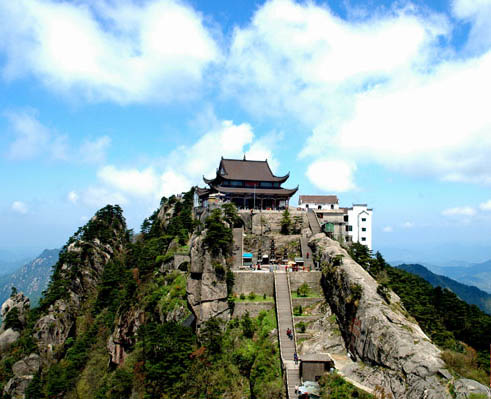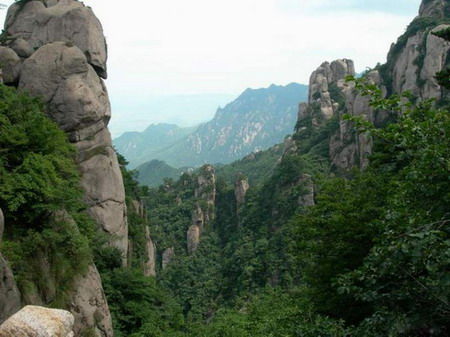Jiu Hua Shan
The Past and the Present
Sacred buddhist mountain in China

Originally this now totally Buddhist dominated area was populated by a few Taoists, who built various temples and houses on the sights of their modern day counterparts. This was all to change with the arrival of a wandering Korean Buddhist called Kim Kiao Kak (Jin Qiaojue), who arrived on the mountain in 720 AD. Kim was alleged to be the reincarnation of the Boddhisattva Dizang, and came here preaching the Buddhist message and founding various temples, mostly in honour of the guardian of the earth, Ksitigarbha.
After his death in 794 AD, the mountain grew in prominence, so that by the mid to late Tang (618-907 AD) there were hundreds of monasteries and thousands of monks in residence. It was during these golden days that the poet Li Bai, sitting on the mountain’s most famous peak, the Heavenly Terrace, penned the areas name. He called it Nine Flower Mountain (Jiuhuashan), after the prominent peaks that he could see around him, jutting through the clouds like newly sprouting buds. There are actually 99 peaks enclosed in the Jiuhuashan area.

Nowadays things are a little smaller around this bit of Anhui. The total number of temples & monasteries has dropped to around 60, lost either through neglect, or the ravages of Red Guard cleansing during the Cultural Revolution (1967-77). The mountain is also becoming a more popular destination on the tourist route, meaning increasing numbers of stalls, renovations, people, modern buildings, cable cars, and rubbish, especially during the peak seasons around festival time. Things in the future are set to get worse.
For the moment, there are around 6,800 Buddhist sculptures, a good selection of calligraphic works, mainly from the Ming (1368-1644 AD) and Qing (1644-1911 AD) Dynasties, and a variety of original Buddhist texts including Wu Xia’s Huayang Sutras, some imperial ordered Qing Dynasty sutras and some ancient Sanskrit sutras. There are also two nicely mummified corpses, one of Wu Xia and the other of Kim Kiao Kak, both covered in a layer of gold leaf.
– Source : Sacredsite.com
– Related articels :
- Four sacred buddhist mountains in China
- Wu Tai Shan: a holy place of buddhism unity
- Putuo Shan: a paradise of buddha in the middle of the sea




